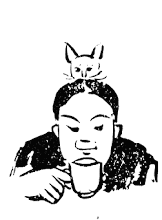Dalí and Hollywood/ 达利与好莱坞
June 29, 2008
Mr. Surrealist Goes to Tinseltown
“I’M in Hollywood,” Salvador Dalí wrote in a postcard to André Breton in 1937, “where I’ve made contact with the three American surrealists, Harpo Marx, Disney and Cecil B. DeMille.”
Dalí’s devious wit was legendary, but in this case it appears he was being sincere. The same year, in Harper’s Bazaar, he sang Hollywood’s praises as an ideal incubator of Surrealism whether Hollywood knew it or not.
“One always more or less believes to have ‘dreamed’ it when one recalls Claudette Colbert bathing in a pool filled with asses’ milk at the beginning of DeMille’s ‘Sign of the Cross,’ ” he wrote of the heavy-breathing 1932 biblical epic, with its gladiators, Christian-devouring crocodiles and other Dalí-esque touches. (The painter later met DeMille and is said to have prostrated himself at the director’s feet.)
Dalí’s worship of the movies and the countless crosscurrents between them and his work are explored in an exhibition opening Sunday at the Museum of Modern Art. It includes more than 100 paintings and drawings, along with Dalí’s own screen creations, “Un Chien Andalou” and “L’Âge d’Or,” made with Luis Buñuel.
The show, organized by the Tate Modern in collaboration with MoMA and the Gala-Salvador Dalí Foundation in Figueres, Spain, chronicles Dalí’s one more or less successful foray into mainstream moviemaking, the dream sequence for Alfred Hitchcock’s “Spellbound” of 1945.
But it also covers the many fascinating might-have-beens. After meeting Harpo Marx in 1937 during his Hollywood trip, Dalí expanded on an earlier idea for a Marx Brothers movie to be called “Giraffes on Horseback Salad,” which would have included a scene of giraffes wearing gas masks and one of Chico sporting a deep-diving suit while playing the piano. Dalí had Cole Porter in mind for the score. He wrote that he hoped it would surpass even the “biological, hysterical and cannibalistic frenzy of ‘Animal Crackers.’ ”
Though Harpo liked it, the movie was never made. Groucho claimed to have scuttled it himself: “It wouldn’t play.”
Jodi Hauptman, a curator of drawings at MoMA, who coordinated the exhibition, said that even as early as the 1920s, “a kind of filmic vision pervaded much of what Dalí was thinking and painting.” It can be seen clearly in well-known works like “The First Days of Spring,” right, which was made in 1929, the same year as “Un Chien Andalou.” Even the painting’s perspective, which she describes as vertiginous, conjures up the feeling of a scene shot by a camera soaring high on a crane.
Anne Morra, an assistant film curator at MoMA who organized the film component of the show, said that the scenes being enacted across the painting’s landscape, some of them overlapping, suggest film’s ability in montage to bring seemingly unrelated images into proximity.
Perhaps above all, Dalí found in the movies an ally, albeit often an unwitting one, in his lifelong campaign to scramble distinctions between real and imagined. “He painted cracks in things and then the paint itself later cracked,” Ms. Hauptman said. “It’s kind of amazing. Did he know the paint was going to crack like that?”
Copyright 2008 The New York Times Company
王小波已经在《革命时期的爱情》里替我们设想了一下:如果超现实的达利在58年来到中国看到大炼钢铁的景象,又会如何?



没有评论:
发表评论